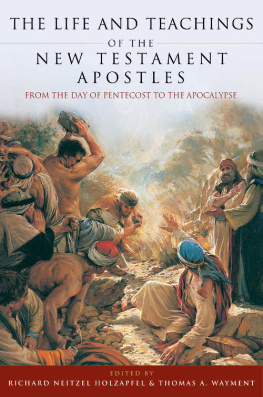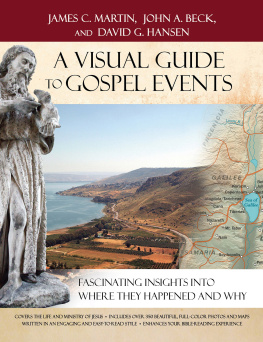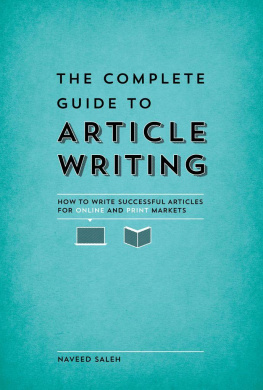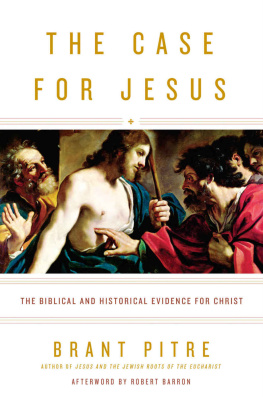Front cover: The Family of Lehi about 600 Years before Christ (1989) by Kelly Hale, oil on canvas, 32" 46", courtesy BYU Jerusalem Center for Near Eastern Studies.
Copyright 2019 Jeffrey R. Chadwick. All rights reserved.
Opinions expressed in this publication are the opinions of the authors and their views should not necessarily be attributed to The Church of Jesus Christ of Latter-day Saints, Brigham Young University, or BYU Studies.
No part of this book may be reprinted or reproduced or utilized in any form or by any electronic, mechanical or other means, now known or hereafter invented, including photocopying and recording or in an information storage or retrieval system, without permission in writing from the publisher. To contact BYU Studies, write to 1063 JFSB, Brigham Young University, Provo, Utah 84602-6720, Provo, Utah 84602, or visit https://byustudies.byu.edu.
Contents
Authors Introduction
Jeffrey R. Chadwick
This book brings together three articles I published in the academic journal BYU Studies Quarterly on the subject of accurately dating key scriptural events. The first article, which debuted in 2010, presents evidence from historical and scriptural sources that suggests Jesus Christ was born in December of the year 5 BC, rather than in April of 1 BC as commonly claimed in traditional Latter-day Saint sources. The second article, which appeared in 2015 as a follow-up to the first, lays out a more complex collection of evidence pointing to the day and date of Jesuss crucifixion and death as a Thursday early in April of AD 30, thirty-three years and three months after his birth. And the third article, published in 2018, assembles a vast array of historical and archaeological data suggesting that the date of Lehis departure from Jerusalem must have been late in the year 605 BC, some six hundred years prior to Jesuss birth in December of 5 BC.
As each of these three studies appeared, they were met with a good deal of surprise, since each was a significant departure from previously accepted notions among Latter-day Saint students of scripture. News media and internet blogging sites covered each of the articles, and while there were a predictable number of immediate naysayers, I was pleased that each article, in its turn, became the subject of serious consideration and debate among colleagues and lay readers alike. As time has passed, a continually increasing number of my colleagues have confided to me that they are convinced by the research and have adjusted their own models to reflect the proposed dating. Eventually, all three articles were presented, by invitation, as the subject of public lectures in the Best of BYU Studies series at BYU Education Week. It has been a rewarding experience to see this research have an impact on how we understand the context and reliability of our scriptural accounts.
It is a fair question to ask why this subject matters. Why should we care about determining exactly, or even approximately, when scripture events occurred? As one recent respondent put it (one who was decidedly not impressed with the content of the article dating Lehis departure): Who cares? Who cares when Lehi left Jerusalem? Who cares when Jesus was born? What does it even really matter? Why waste time arguing about things that dont matter? The answer is that for some peoplecertainly not all, but definitely somethe historical and contextual authenticity of scripture are important factors in both their understanding of and testimony of both the Bible and the Book of Mormon. Such factors may not be vital or impressive to certain readers, and that is just fine. But for other students of the scriptures, the factual reality and reliability of the events reported can be significantly enlightening and uplifting components of their overall study and appreciation of our sacred writ. And it is precisely that audience for whom these studies have been prepared. One of my favorite privileges in courses I teach is to bear a dual witness of our ancient scriptures to my students: The Bible and the Book of Mormon are both spiritually true and also historically and materially authentic. Accurate dating of scriptural events is a significant factor in establishing material authenticity.
On another level, wanting to know with some degree of accuracy what the dates of events in our scriptures were, and particularly in the life of Jesus, can represent part of a students personal involvement in the events. It is often suggested that we consider Jesus to be our personal Savior, and also our personal friendindeed, he has frequently called us his friends (John 15:1415; D&C 84:77; 93:45; 94:1; 98:1; 104:1). Generally, most of us will know significant things about our friends, including their birthdays and other important events in their lives. For me, personally, the effort to ascertain the date of Jesuss birth has not been a mere historical exercise; it has been an effort to learn more about him personally and has drawn me nearer to him who calls me friend. I have hoped that, for some readers, at least, contemplating these studies will have the same effect.
Since the issues surrounding the dating of scriptural events are quite complex, it is also fair to ask what qualifies the author to undertake this research and offer the conclusions presented in these studies. A biographical paragraph summarizing my teaching and research career will appear at the end of this ebook. For now, I will just mention that 2019 marks my fortieth year as a professional religious educator and Ancient Near Eastern researcher. I began my career in the fall of 1979, as a young LDS seminary instructor in Roy, Utah. A graduate degree in historical geography of the Ancient Near East got me invited to teach in BYUs study abroad program in Jerusalem in 1982, and a later PhD in the archaeology of the Near East led to a continuing series of assignments at the BYU Jerusalem Center. After several years teaching for LDS Institutes at Utah State and Weber State University, I joined the BYU Religious Education faculty with an associated assignment of regular Jerusalem Center teaching. So far, over thirty-five different years in Israel, I have served in twenty-three different Jerusalem Center student programs, and I have also worked as a supervising archaeologist in twenty-three seasons of field excavation with major expeditions at significant biblical sites in Israel. It has been an unusual but rewarding career combination, for which I have been grateful. And although it took a few decades, I eventually accumulated enough experience in the archaeology, geography, history, and associated contextual subjects of the ancient biblical lands to feel comfortable tackling the complicated topics involved in the studies presented in these three BYU Studies articles.
So here, now, for your consideration, is the reprint of the 2010 study, Dating the Birth of Jesus Christ, the first segment of what has come to be informally known as the dating trilogy.
Dating the Birth of Jesus Christ
Jeffrey R. Chadwick
First published in BYU Studies 49, no. 4 (2010): 438.
In his 1915 classic entitled Jesus the Christ, Elder James E. Talmage maintained that Jesus Christ was born on April 6 in the year 1 BC. Talmage was apparently the first LDS writer to propose this particular date. Nearly a century has passed since his book appeared, and in that time it has become practically axiomatic among Latter-day Saints that Jesus was born on April 6 in that year. But was he?
In the last century, much new information has come to light about the New Testament. New data from archaeological and historical sources, combined with a reexamination of the scriptural accounts involved, suggest that the April 6 dating should be reconsidered. In this article, I strive to show why I prefer a narrow window of time at the beginning of winter for the birth of the Savior and propose that Jesus was quite likely born in December of the year 5 BC.









